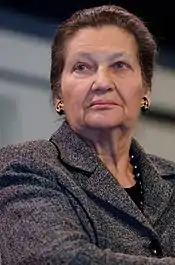History of the European Communities (1973–1993)
Between 1973 and 1993 the European Communities saw the first enlargement of the Communities and increasing integration under the Delors Commission leading to the creation of the European Union in 1993.
Part of a series on the |
|---|
| History of the European Union |
 |
|
|
On 1 January 1973, Denmark, Ireland, and the United Kingdom became the first countries to join the Communities. The newly enlarged Ortoli Commission took office under François-Xavier Ortoli on 5 January. The first Commission to be led by a member from the new states was the Jenkins Commission, of the UK's Roy Jenkins who held office between 1977 and 1981. Following on was the Thorn Commission, which oversaw the completion of the customs union and then 1985 saw the first Delors Commission.
First elections

The Treaties of Rome had stated that the European Parliament must be directly elected, however this required the Council to agree on a common voting system first. The Council procrastinated on the issue and the Parliament remained appointed,[1] French President Charles de Gaulle was particularly active in blocking the development of the Parliament, with it only being granted Budgetary powers following his resignation.
Parliament pressured for agreement and on 20 September 1976 the Council agreed part of the necessary instruments for election, deferring details on electoral systems which remain varied to this day.[1] During the tenure of President Jenkins, in June 1979, the elections were held in all the then-members. 410 MEPs were elected and at their first meeting they elected a new President of the European Parliament; Simone Veil, a French liberal who was the first woman to be elected to the post.[2]
The new Parliament, galvanised by direct election and new powers, started working full-time and became more active than the previous assemblies. The elections also helped cement the political groups and, despite attempts by the larger groups to consolidate their position, smaller parties began to co-operate and form alliances.[1] In the subsequent elections (1984 and 1989) the electorate expanded to include new member states and the left wing parties saw increasing electoral gains. However, turnout began to drop from 63% in 1979 to 58% in 1989.
| European Parliament election, 1979 - Final results at 17 July 1979 | ||||||
|---|---|---|---|---|---|---|
| Group | Description | Chaired by | MEPs | |||
| SOC | Social Democrats | Ernest Glinne | 113 |  | ||
| EPP | Christian Democrats | Egon Klepsch | 107 | |||
| ED | Conservatives | James Scott-Hopkins | 64 | |||
| COM | Communists and the Far Left | Giorgio Amendola | 44 | |||
| LD | Liberals and Liberal Democrats | Martin Bangemann | 40 | |||
| EPD | National Conservatives | Christian de La Malène | 22 | |||
| CDI | Heterogeneous | Marco Pannella Neil Blaney Jens-Peter Bonde |
11 | |||
| NI | Independents | none | 9 | Total: 410 | Sources: | |
Further enlargement

Greece, already an associate member (the first) since 1961, applied to join the community on 12 June 1975 following the restoration of democracy. It joined on 1 January 1981.[3] In 1985, after gaining home rule from Denmark, Greenland left the community following a referendum but remained an overseas territory.
Following on from Greece, and after their own democratic restoration, Spain and Portugal applied to the communities in 1977. They joined together on 1 January 1986.[4] In 1987 Turkey formally applied to join the Community and began the longest application process for any country.
Copenhagen criteria
Following the fall of the Iron Curtain the door to enlargement to the former eastern bloc was opened. In response leaders gathered in Copenhagen on 22 June 1993 to define entry conditions for candidate states. These criteria were later included in the Maastricht Treaty. The following is an excerpt from the criteria;[5]
"Membership requires that the candidate country has achieved stability of institutions guaranteeing democracy, the rule of law, human rights and respect for and, protection of minorities, the existence of a functioning market economy as well as the capacity to cope with competitive pressure and market forces within the Union. Membership presupposes the candidate's ability to take on the obligations of membership including adherence to the aims of political, economic and monetary union."
Treaties
The Single European Act was signed by the foreign ministers on 17 and 28 February 1986 in Luxembourg and the Hague respectively. In a single document it dealt with reform of institutions, extension of powers, foreign policy cooperation and the single market. It came into force on 1 July 1987.[6]
The act was influenced by work on what would be the Maastricht Treaty, the Treaty establishing the European Union. There had previously been plans to create a more integrated body and, spurred on by enlargement, various groups put forward plans. Building on the legitimacy of its elections, in 1984 the Parliament produced the Spinelli plan. The draft treaty establishing a European Union, which was inspired by the failed European Political Community, was adopted by the Parliament 237 votes to 31 (43 abstentions). It would have given a more federal structure using the community method and codecision with the parliament, however it failed to win the support of the member states. (See also: Crocodile Club)[7]
Similar proposals from the Commission collapsed due to arguments over the UK rebate (secured by British Prime Minister Margaret Thatcher in 1984)[8] and a German-Italian proposal resulted in the Solemn Declaration on European Union of 19 June 1983 as a political impetus towards a Union but not itself a binding treaty. A treaty establishing the European Union was eventually agreed on 10 December 1991 and signed on 7 February of the following year. Denmark lost a referendum on ratification but succeeded in a second attempt after securing four opt-outs. The Treaty came into force on 1 November 1993.
Delors era
Jacques Delors' Commission, serving from 1985 to 1994, is regarded as the most successful in history, becoming a frequent source of comparison to his successors.[9]
Delors presided over accession of Spain and Portugal, the fall of Communism with the reunification of Germany in 1990, the adoption of the European flag, the Single European Act, the Maastricht Treaty, the beginnings of EMU, the signing of the Schengen Agreement (19 June 1990) and the completion of the single market.[6][10]
See also
| Wikisource has original text related to this article: |
References
- Source of majority of the dates: A growing community – more countries join and the changing face of Europe – the fall of the Berlin Wall
- Hoskyns, Catherine; Newman, Michael (2000). Democratizing the European Union: issues for the twenty-first century (Perspectives on Democratization). Manchester: Manchester University Press. ISBN 978-0-7190-5666-6.
- "European Parliament press releases". 19 February 2014. Archived from the original on 19 February 2014.
- The accession treaty with Greece CVCE.eu
- The Accession Treaties with Spain and Portugal CVCE.eu
- Conclusions from the Copenhagen European Council CVCE.eu
- Single European Act CVCE.eu
- The European Parliament's proposals CVCE.eu
- The European Commission's proposals CVCE.eu
- THE NEW COMMISSION - SOME INITIAL THOUGHTS Archived 2006-09-23 at the Wayback Machine bmbrussels.be
- The fall of the Berlin Wall Europa.eu
| 1958–1972 | Timeline of European Union history 1973–1993 |
1993–2004 |